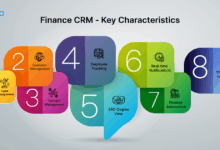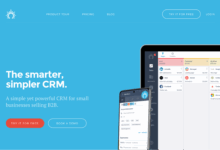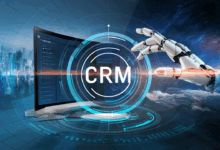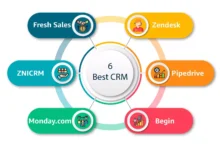CRM with AI Chatbot Integration: Enhanced Customer Engagement
CRM with AI Chatbot Integration represents a significant advancement in customer relationship management. By seamlessly blending the power of CRM systems with the intelligent capabilities of AI chatbots, businesses can revolutionize how they interact with customers, leading to increased efficiency, improved customer satisfaction, and ultimately, higher profitability. This integration allows for personalized interactions at scale, automating routine tasks and freeing up human agents to focus on more complex issues.
This exploration delves into the core functionalities of CRM systems enhanced by AI chatbots, examining the various types of AI chatbots available and showcasing successful implementations across diverse industries. We’ll explore the benefits, including improved customer service, increased sales efficiency, and cost savings, and provide a detailed look at the implementation process, addressing technical considerations and potential challenges. Finally, we will examine future trends and the potential impact of emerging technologies on this transformative integration.
Defining CRM with AI Chatbot Integration
Customer Relationship Management (CRM) systems are the backbone of modern business operations, enabling companies to manage and analyze customer interactions and data throughout the customer lifecycle. Effective CRM streamlines processes, improves customer service, and ultimately drives revenue growth. Integrating AI-powered chatbots significantly enhances these core functionalities, leading to more efficient and personalized customer experiences.
AI chatbot integration boosts CRM capabilities by automating routine tasks, providing instant support, and offering personalized interactions. This allows human agents to focus on more complex issues, improving overall efficiency and customer satisfaction. The ability of AI chatbots to analyze large datasets and identify patterns also enables businesses to gain valuable insights into customer behavior and preferences, informing strategic decision-making.
Core Functionalities of a CRM System
CRM systems offer a wide range of functionalities designed to improve customer interactions and data management. These include contact management, sales force automation, marketing automation, customer service support, and reporting and analytics. Contact management involves storing and organizing customer information, while sales force automation streamlines sales processes, such as lead generation and opportunity management. Marketing automation helps automate marketing tasks, like email campaigns and social media posts, while customer service support facilitates efficient handling of customer inquiries and issues. Finally, reporting and analytics provide insights into customer behavior and business performance.
AI Chatbot Enhancement of CRM Capabilities
The integration of AI chatbots significantly enhances several key areas within a CRM system. Firstly, it automates routine customer service inquiries, freeing up human agents to handle more complex problems. Secondly, it provides 24/7 availability, ensuring customers receive immediate assistance regardless of time zone. Thirdly, AI chatbots can personalize interactions based on customer data, offering tailored recommendations and support. Fourthly, they can collect valuable customer data, such as preferences and pain points, which can be used to improve products and services. Finally, they improve response times and reduce resolution times for customer queries, enhancing customer satisfaction.
Types of AI Chatbots Used in CRM
Several types of AI chatbots are utilized in CRM systems, each with its own strengths and applications. Rule-based chatbots follow pre-defined rules and scripts to respond to customer inquiries. These are relatively simple to implement but lack flexibility. Machine learning (ML) chatbots learn from past interactions and improve their responses over time. These offer greater flexibility and personalization. Natural Language Processing (NLP) chatbots are designed to understand and respond to human language more naturally, leading to more human-like interactions. Hybrid chatbots combine different approaches, often leveraging the strengths of rule-based, ML, and NLP technologies to deliver a comprehensive solution.
Examples of Successful CRM with AI Chatbot Implementations
Companies across various industries have successfully integrated AI chatbots into their CRM systems. For instance, in the e-commerce sector, companies like Sephora use chatbots to provide personalized product recommendations and answer customer queries, leading to increased sales and improved customer satisfaction. In the banking industry, chatbots handle routine transactions, such as balance inquiries and account transfers, freeing up human tellers to focus on more complex issues. In the healthcare industry, chatbots are used to schedule appointments, answer patient questions, and provide medication reminders, improving patient care and efficiency. These examples highlight the versatility and effectiveness of AI chatbot integration in CRM across diverse sectors.
Implementation and Integration
Integrating an AI chatbot into your existing CRM system offers significant potential for enhancing customer service and streamlining internal processes. Successful implementation, however, requires careful planning and execution, considering both technical and logistical factors. This section outlines the key steps, considerations, and potential challenges involved in this integration process.
Steps Involved in Integrating an AI Chatbot into an Existing CRM
The integration process typically involves several key steps, each demanding careful attention to detail. A phased approach is often beneficial, allowing for testing and refinement at each stage. Ignoring any step can lead to unexpected complications later in the process.
- API Selection and Authentication: Begin by selecting the appropriate API (Application Programming Interface) for both your CRM and your AI chatbot platform. This API will serve as the communication bridge between the two systems. Secure authentication methods must be established to ensure data security and integrity.
- Data Mapping and Transformation: Identify the relevant data points that need to be exchanged between the CRM and the chatbot. This might include customer information, interaction history, and support tickets. Data transformation might be necessary to ensure compatibility between the two systems’ data formats.
- Development and Testing: Develop the integration code, ensuring seamless data flow and accurate functionality. Thorough testing is crucial to identify and resolve any bugs or inconsistencies before deploying the integration to a live environment. This involves unit testing, integration testing, and user acceptance testing.
- Deployment and Monitoring: Deploy the integrated system to your live environment. Continuous monitoring is essential to track performance, identify any issues, and make necessary adjustments. This includes monitoring response times, error rates, and user satisfaction.
- Training and Refinement: Continuously train the AI chatbot with new data and refine its responses based on user interactions and feedback. This iterative process is crucial for improving the chatbot’s accuracy and effectiveness over time.
Technical Considerations for Successful Integration
Several technical aspects must be carefully considered to ensure a smooth and effective integration. Overlooking these can lead to significant problems and hinder the overall success of the implementation.
- API Compatibility: Ensure compatibility between the APIs of your CRM and AI chatbot platform. Differences in data formats, authentication methods, or communication protocols can create significant integration challenges.
- Data Security and Privacy: Implement robust security measures to protect sensitive customer data during the integration process and ongoing operation. Compliance with relevant data privacy regulations (like GDPR or CCPA) is paramount.
- Scalability and Performance: Design the integration to handle increasing volumes of data and user interactions without compromising performance. This requires careful consideration of infrastructure capacity and optimization techniques.
- Error Handling and Logging: Implement comprehensive error handling and logging mechanisms to facilitate troubleshooting and identify potential issues promptly. This allows for quicker resolution of problems and prevents service disruptions.
Challenges and Potential Pitfalls of Implementation
Implementing an AI chatbot into a CRM system is not without its challenges. Understanding these potential pitfalls is crucial for mitigating risks and ensuring a successful integration.
One common challenge is ensuring data consistency between the CRM and the chatbot. Discrepancies can lead to inaccurate information being presented to customers. Another potential pitfall is the complexity of integrating with legacy CRM systems, which may lack the necessary APIs or have outdated infrastructure. Finally, insufficient training data can result in an AI chatbot that is unable to adequately handle customer queries.
Step-by-Step Guide for Configuring an AI Chatbot within a CRM System
A specific step-by-step guide would need to be tailored to the specific CRM and AI chatbot platform being used. However, a generalized approach involves these steps:
- Create a Chatbot Account: Set up an account with your chosen AI chatbot platform.
- Configure Chatbot Settings: Customize the chatbot’s personality, responses, and knowledge base.
- Integrate with CRM API: Use the API provided by both the CRM and the chatbot to establish a connection.
- Map Data Fields: Define which data points from the CRM will be accessible to the chatbot.
- Test the Integration: Thoroughly test the integration to ensure seamless data flow and accurate responses.
- Deploy to Production: Once testing is complete, deploy the integrated system to your live environment.
Flowchart Illustrating the Integration Process
[Imagine a flowchart here. The flowchart would begin with “Start,” then branch to “Select API & Authentication,” “Data Mapping & Transformation,” “Development & Testing,” “Deployment & Monitoring,” and finally “End.” Each step would have a decision point (yes/no) to check for successful completion before proceeding to the next. Error handling would be shown as loops back to previous steps for correction. The flowchart would visually represent the iterative and cyclical nature of the implementation process.]
AI Chatbot Features and Capabilities
Integrating AI chatbots into a CRM system significantly enhances customer interaction and operational efficiency. These chatbots leverage advanced technologies to provide personalized, efficient, and scalable support, leading to improved customer satisfaction and increased business productivity. This section details the key features and capabilities that contribute to this enhanced functionality.
AI chatbots offer a range of features that streamline CRM processes and improve customer engagement. Their core functionality relies on a combination of Natural Language Processing (NLP), Machine Learning (ML), and sentiment analysis to understand, respond to, and learn from customer interactions.
Natural Language Processing (NLP) and Improved Customer Interactions
Natural Language Processing enables the chatbot to understand and respond to human language in a natural and intuitive way. This goes beyond simple keyword matching; NLP allows the chatbot to interpret the intent behind a customer’s message, even if it’s phrased differently than expected. For example, a customer might ask “How do I cancel my order?” or “I want to cancel my order,” both conveying the same intent. NLP ensures the chatbot correctly understands and responds appropriately, leading to smoother and more efficient interactions. The use of NLP significantly reduces the frustration customers often experience when interacting with rigid, rule-based systems.
Machine Learning (ML) and Personalized Customer Experiences
Machine learning algorithms allow the chatbot to learn from past interactions and continuously improve its performance. This means the chatbot can personalize responses based on individual customer preferences, past interactions, and purchase history. For instance, a chatbot can offer tailored product recommendations based on a customer’s browsing history or suggest solutions to problems based on similar issues encountered by other customers. This personalization fosters stronger customer relationships and increases the likelihood of repeat business. ML algorithms can also predict customer behavior, allowing businesses to proactively address potential issues before they escalate.
Sentiment Analysis and Understanding Customer Feedback
Sentiment analysis is a crucial feature that allows the chatbot to gauge the emotional tone of customer interactions. By analyzing the language used in a customer’s message, the chatbot can determine whether the customer is happy, frustrated, or angry. This real-time feedback is invaluable for understanding customer sentiment and identifying potential areas for improvement in products, services, or customer support processes. For example, if a significant number of customers express negative sentiment regarding a specific product feature, the business can use this information to address the issue promptly.
Advanced AI Chatbot Capabilities
Beyond the core functionalities, advanced AI chatbots offer a range of capabilities that further enhance CRM effectiveness. These capabilities often involve more sophisticated algorithms and integrations with other systems.
- Proactive Support: Chatbots can proactively reach out to customers based on predefined triggers, such as abandoned shopping carts or missed appointments, offering assistance and potentially preventing churn.
- Predictive Analytics: By analyzing customer data, chatbots can predict future customer behavior, such as potential churn or likely purchases, enabling businesses to take proactive steps to retain customers or upsell products.
- Personalized Recommendations: Chatbots can offer highly personalized product or service recommendations based on a customer’s individual preferences, purchase history, and browsing behavior, leading to increased sales and customer satisfaction.
- Integration with other CRM tools: Seamless integration with other CRM systems allows for a unified view of customer data and facilitates efficient workflow management.
Case Studies and Examples
The successful integration of AI chatbots into CRM systems has yielded significant improvements across various industries. Several companies have demonstrated the transformative potential of this technology, achieving measurable improvements in key performance indicators and realizing substantial returns on investment. The following case studies illustrate the diverse applications and tangible benefits of AI-powered CRM chatbots.
Examples of Successful AI Chatbot CRM Integration
Several companies have successfully integrated AI chatbots into their CRM systems, resulting in improved customer service, increased sales, and reduced operational costs. These examples highlight the versatility and effectiveness of this technology across different sectors. For instance, a large e-commerce company implemented an AI chatbot to handle customer inquiries regarding order status, shipping information, and returns. This resulted in a significant reduction in call center volume and improved customer satisfaction scores. Another example involves a financial institution that used an AI chatbot to provide personalized financial advice and support to its customers, leading to increased customer engagement and improved cross-selling opportunities. A healthcare provider successfully used an AI chatbot to schedule appointments, answer patient questions, and provide medication reminders, improving patient experience and reducing administrative burden.
Impact on Key Performance Indicators (KPIs)
The integration of AI chatbots into CRM systems has demonstrably impacted key performance indicators across various organizations. Metrics such as customer satisfaction (CSAT), Net Promoter Score (NPS), and average handling time (AHT) have shown significant improvements. For example, one company reported a 20% increase in CSAT scores after implementing an AI chatbot to handle routine customer inquiries. Another company saw a 15% reduction in AHT due to the chatbot’s ability to efficiently resolve simple issues. Furthermore, some companies have reported a significant increase in lead conversion rates and sales revenue as a result of improved customer engagement and personalized communication facilitated by AI chatbots. These improvements demonstrate the tangible value that AI chatbot integration can bring to an organization’s bottom line.
Industry-Specific Adaptations of AI Chatbot Integration
AI chatbot integration is not a one-size-fits-all solution. Different industries have adapted the technology to meet their unique needs and challenges. In the retail sector, chatbots are often used for product recommendations, order tracking, and customer support. In the financial services industry, chatbots are employed for account balance inquiries, fraud detection, and personalized financial advice. The healthcare industry utilizes chatbots for appointment scheduling, medication reminders, and patient education. The education sector employs chatbots to answer student inquiries, provide course information, and offer technical support. This adaptability underscores the versatility of AI chatbots in addressing specific industry requirements.
Return on Investment (ROI) of AI Chatbot Integration
The ROI of AI chatbot integration varies depending on factors such as implementation costs, chatbot features, and the specific business goals. However, many companies have reported significant returns on their investment. Cost savings are often realized through reduced labor costs in customer service and support. Increased efficiency and productivity, improved customer satisfaction, and higher conversion rates all contribute to a positive ROI. For instance, a company might invest $50,000 in implementing an AI chatbot, but subsequently save $100,000 annually in customer service costs, resulting in a significant return on investment. The long-term benefits, such as improved customer loyalty and brand reputation, further enhance the overall ROI.
Case Study Table
| Company | Industry | Implementation Details | Results |
|---|---|---|---|
| Example Company A | E-commerce | Integrated AI chatbot for order tracking and customer support. | 25% reduction in customer service calls, 15% increase in customer satisfaction. |
| Example Company B | Financial Services | Implemented AI chatbot for account balance inquiries and fraud detection. | 10% reduction in fraud cases, 5% increase in customer engagement. |
| Example Company C | Healthcare | Used AI chatbot for appointment scheduling and medication reminders. | 10% increase in appointment adherence, 8% reduction in missed appointments. |
| Example Company D | Education | Deployed AI chatbot to answer student inquiries and provide course information. | Improved student satisfaction, reduced administrative workload. |
Future Trends and Predictions
The integration of AI and chatbots within CRM systems is rapidly evolving, promising a future where customer interactions are more efficient, personalized, and insightful than ever before. This section explores the anticipated advancements and the transformative impact these technologies will have on the way businesses manage customer relationships.
The evolving role of AI in CRM systems will see a shift from basic automation to sophisticated predictive analytics and personalized customer journeys. AI will increasingly handle complex tasks, freeing up human agents to focus on higher-value interactions. This will lead to improved customer satisfaction and increased operational efficiency.
Advancements in AI Chatbot Technology for CRM
AI chatbot technology is poised for significant advancements. Expect to see improvements in natural language processing (NLP) leading to more natural and human-like conversations. Contextual understanding will improve dramatically, allowing chatbots to remember past interactions and personalize future engagements. The integration of machine learning (ML) will enable chatbots to continuously learn and adapt, improving their performance over time. For example, chatbots will become better at identifying customer sentiment and proactively addressing potential issues. Furthermore, the ability to seamlessly integrate with other CRM functionalities, such as sales and marketing automation, will become increasingly sophisticated, creating a truly unified customer experience.
Impact of Emerging Technologies on CRM with AI Chatbots
The convergence of AI chatbots with emerging technologies like voice assistants and augmented reality will revolutionize CRM. Voice assistants will enable hands-free interaction, making CRM accessible in various contexts. Imagine a field service technician using a voice-activated chatbot to access customer information and update service records while on-site. Augmented reality (AR) can overlay customer information directly onto the technician’s view, providing real-time context and enhancing efficiency. This integration will not only streamline workflows but also improve the overall customer experience by providing faster and more convenient service.
Future Applications of AI Chatbots in CRM
Future applications of AI chatbots in CRM extend beyond simple customer service. They will play a crucial role in lead generation and qualification, providing instant responses to inquiries and guiding prospects through the sales funnel. Predictive analytics capabilities will allow chatbots to identify high-potential leads and personalize outreach efforts. In marketing, AI-powered chatbots can create highly targeted campaigns by analyzing customer data and preferences. They can also personalize product recommendations and offer proactive support based on individual customer needs. For instance, an e-commerce platform could use a chatbot to anticipate a customer’s need for assistance during the checkout process, reducing cart abandonment rates.
A Futuristic CRM System with Advanced AI Chatbot Capabilities
Imagine a futuristic CRM system where a sophisticated AI chatbot acts as a central hub for all customer interactions. This chatbot seamlessly integrates with various systems, providing a unified view of each customer’s journey. It anticipates customer needs, proactively offering support and personalized recommendations. The chatbot utilizes advanced NLP and ML to understand complex queries and respond with human-like empathy and accuracy. Real-time data analysis provides insights into customer behavior, allowing the system to optimize marketing campaigns and improve sales strategies. This system isn’t just a tool for managing customer interactions; it’s a strategic partner, enabling businesses to build stronger relationships and drive revenue growth. For example, a sales representative could use this system to access a complete history of interactions with a client, including past purchases, service requests, and even social media interactions, all within a single interface powered by the advanced AI chatbot. This comprehensive view enables the representative to tailor their approach, leading to improved conversion rates and stronger client relationships.
Final Wrap-Up
In conclusion, integrating AI chatbots into CRM systems offers a compelling path towards enhanced customer engagement and operational efficiency. The ability to automate tasks, personalize interactions, and gain valuable customer insights through data analysis provides a significant competitive advantage. While implementation requires careful planning and consideration of technical aspects, the potential return on investment and long-term benefits make CRM with AI chatbot integration a strategic imperative for businesses seeking to thrive in today’s dynamic marketplace. The future of CRM is undoubtedly intertwined with the ongoing advancements in AI technology, promising even more sophisticated and impactful applications in the years to come.





